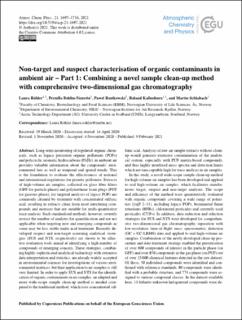| dc.description.abstract | Long-term monitoring of regulated organic chemicals, such as legacy persistent organic pollutants (POPs) and polycyclic aromatic hydrocarbons (PAHs), in ambient air provides valuable information about the compounds' environmental fate as well as temporal and spatial trends. This is the foundation to evaluate the effectiveness of national and international regulations for priority pollutants. Extracts of high-volume air samples, collected on glass fibre filters (GFF for particle phase) and polyurethane foam plugs (PUF for gaseous phase), for targeted analyses of legacy POPs are commonly cleaned by treatment with concentrated sulfuric acid, resulting in extracts clean from most interfering compounds and matrices that are suitable for multi-quantitative trace analysis. Such standardised methods, however, severely restrict the number of analytes for quantification and are not applicable when targeting new and emerging compounds as some may be less stable under acid treatment. Recently developed suspect and non-target screening analytical strategies (SUS and NTS, respectively) are shown to be effective evaluation tools aimed at identifying a high number of compounds of emerging concern. These strategies, combining highly sophisticated analytical technology with extensive data interpretation and statistics, are already widely accepted in environmental sciences for investigations of various environmental matrices, but their application to air samples is still very limited. In order to apply SUS and NTS for the identification of organic contaminants in air samples, an adapted and more wide-scope sample clean-up method is needed compared to the traditional method, which uses concentrated sulfuric acid. Analysis of raw air sample extracts without clean-up would generate extensive contamination of the analytical system, especially with PUF matrix-based compounds, and thus highly interfered mass spectra and detection limits which are unacceptable high for trace analysis in air samples. In this study, a novel wide-scope sample clean-up method for high-volume air samples has been developed and applied to real high-volume air samples, which facilitates simultaneous target, suspect and non-target analyses. The scope and efficiency of the method were quantitatively evaluated with organic compounds covering a wide range of polarities (logP 2–11), including legacy POPs, brominated flame retardants (BFRs), chlorinated pesticides and currently used pesticides (CUPs). In addition, data reduction and selection strategies for SUS and NTS were developed for comprehensive two-dimensional gas chromatography separation with low-resolution time-of-flight mass spectrometric detection (GC × GC-LRMS) data and applied to real high-volume air samples. Combination of the newly developed clean-up procedure and data treatment strategy enabled the prioritisation of over 600 compounds of interest in the particle phase (on GFF) and over 850 compounds in the gas phase (on PUF) out of over 25 000 chemical features detected in the raw dataset. Of these, 50 individual compounds were identified and confirmed with reference standards, 80 compounds were identified with a probable structure, and 774 compounds were assigned to various compound classes. In the dataset available here, 11 hitherto unknown halogenated compounds were detected. These unknown compounds were not yet listed in the available mass spectral libraries. | en_US |

